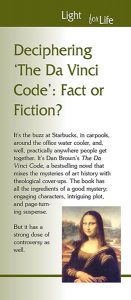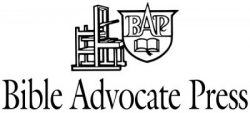 It’s the buzz at Starbucks, in carpools, around the office water cooler, and, well, practically anywhere people get together. It’s Dan Brown’s The Da Vinci Code, a bestselling novel that mixes the mysteries of art history with theological cover-ups. The book has all the ingredients of a good mystery: engaging characters, intriguing plot, and page-turning suspense.
It’s the buzz at Starbucks, in carpools, around the office water cooler, and, well, practically anywhere people get together. It’s Dan Brown’s The Da Vinci Code, a bestselling novel that mixes the mysteries of art history with theological cover-ups. The book has all the ingredients of a good mystery: engaging characters, intriguing plot, and page-turning suspense.
But it has a strong dose of controversy as well.
The novel’s disclaimer at the front states that all its historical elements are accurate, when in reality they are not. Among other things, the book calls into question . . .
Christ’s deity. According to Brown’s “facts,” Jesus was understood to be a mere mortal by early Christians, until the Council of Nicaea convened in a.d. 325. There the Roman church adopted His divinity by a narrow vote, under heavily politicized conditions.
The Bible. Da Vinci says this Book was written by men, not by God. The four Gospels — Matthew, Mark, Luke, and John — were selected for inclusion in our Bibles a few hundred years after Christ. As many as 80 other writings on the life and teachings of Jesus also existed, many of which enjoyed wide popularity and should have been included in the canon of Scripture.
Mary Magdalene. The Bible is thought to portray her as a prostitute, but this, too, is one of the historical lies that Da Vinci exposes. Brown’s novel identifies Mary as the true head of the church, the wife of Jesus, and the mother of His child. She is the essence of the “sacred feminine” that has been lost in the male-dominated church.
Interesting fiction, for sure — but far from fact.
The Da Vinci Code may be entertaining reading, but be careful! For the multitudes who have read Brown’s book as gospel and think they’ve finally learned the truth about the foundations of Christianity, it’s time to distinguish fact from fiction.
Jesus’ divinity
The truth of Jesus’ divinity and relation with God the Father was notdeveloped first at the Council of Nicaea, three centuries after His earthly life, death, and resurrection. Instead, the four Gospels — all written in the first generation after Christ — affirm the church’s early understanding of a divine and human Savior, Jesus.
The apostle John especially, writing no later than a.d. 90, affirmed the eternal divine nature of the One who “became flesh and made His dwelling among us” (John 1:14). He was, wrote John, “with God” and He “was God” (v. 1). Among many allusions to the deity of Christ in the fourth Gospel are the words of a doubter, Thomas, when he met the risen Christ: “My Lord and my God!” (John 20:28).
If seekers carefully read the New Testament, they’ll see that Jesus’ followers viewed Him as much more than a mortal prophet. Also, the timeless origin of Christ with His Father in heaven (that is, His deity) was known and proclaimed by the early church from its inception — and before:
- Peter had recognized Jesus as more than an Elijah but as “the Christ, the Son of the living God.” This is language used for none but the only begotten Son, who fully knows — and is known by — the Father (Matthew 16:13-16; 11:27).
- In letters dating to the mid-first century, the apostle Paul wrote of Christ’s preexistence in the form of God (Philippians 2:5-8).
- In the same passage, Paul used what is now recognized as part of the earliest Christian creed: “Jesus Christ is Lord” (Philippians 2:9-11). In using this terminology, the first century church consciously adopted an Old Testament name for Deity to refer to God’s Son.
- Many other passages in the New Testament literature, all produced in the first century, either refer to Jesus Christ as God or ascribe to Him the prerogatives of God: He creates (John 1:3; Hebrews 1:3); He receives worship (Luke 24:50-53; Revelation 5:11-13); He hears prayer (Acts 7:59; Revelation 22:20b); He forgives sins (Mark 2:5-7); etc.
It is a New Testament fact that the earliest Christians applied to Jesus several Old Testament passages referring to Yahweh and that they worshipped Christ, calling Him Lord. Outside the Bible, Pliny, writing to the Roman Emperor Trajan early in the second century, described the church as those who “sing a song to Christ as to a God.”
The Bible
Although God used human instruments to write, He authored the Bible. In this regard, the written Word (Scripture) and the living Word (Jesus Christ) are alike: fully human and fully divine.
In speaking to our joys, our sorrows, and our human perplexities as no other book can, the Bible bears the stamp of its divine origin. People who know its Author recognize its inspiration (2 Timothy 3:16, 17). Without the authority of Scripture, we are left to the chaos of agnosticism and doubt. It’s either the Bible or blindness!
Matthew, Mark, Luke, and John were among the earliest Gospels that circulated after the death, resurrection, and ascension of Jesus Christ. True, other “Gospels” were also present in some churches and regions during the early Christian era (partial manuscript has been found from no more than twelve), but none of them was received, read, and respected as widely as these four. Rather than settling some dispute, the listing of Matthew, Mark, Luke, and John in the official canons of the church around a.d. 400 simply confirmed what had been obvious to most of the church for decades or centuries.
Although the Roman Emperor Constantine, hoping to maintain peace in his empire, called the famous Council at Nicaea in a.d. 325, he did not participate in the biblical debates nor did he manipulate the outcome. Constantine’s interest was not so much in theology as in harmony. The historical records show that the council’s decision came from the 318 local bishops who attended, most of whom were from the eastern regions of the empire. They were men who represented churches of long existence. Some had endured persecution before Constantine came to power, and they knew no allegiance to a Roman Catholic Church that did not yet exist. They were not at all likely to abandon their heritage to an emperor, Christian or not, who might impose ideas contrary to their conviction — and no records from that era indicate that they did!
Eerdmans’ Handbook to the History of Christianity reports:
Although churchmen in a literal sense created the canon, they were only recognizing the books that had stamped their own authority on the churches. The criteria for accepting a book as canonical were sometimes complex. Above all, it had to be written or sponsored by an apostle, and also be recognizably orthodox in content, and publicly used by a prominent church or majority of churches. Known forgeries, such as the Acts of Paul, were rejected; as were other books which contained heretical teaching (p. 106).
Mary Magdalene
The fantasy that Mary Magdalene was married to Jesus, carried His child, and was intended by Him to carry on the Christian church has no reliable source — certainly none in the Bible. Despite Brown’s claim that her reputation as a prostitute has deprived her of deserved reverence, scholars have long acknowledged that her identity with the “woman who had lived a sinful life” (Luke 7:37ff) is highly speculative. The Bible says merely that she was among those women whom Jesus delivered from oppression and disease (Luke 8:1-3) and who remained disciples throughout the crisis of His death and afterward.
While the Bible warns us not to worship anyone or anything other than God or Jesus Christ, it does not degrade the female gender. Jesus was respectful and compassionate toward women and regarded their value and dignity in the sight of God as equal to that of men.
A Good Book?
But why should anyone believe what the Bible says about Jesus over what The Da Vinci Code says? Because the Bible is authentic. Books and authors come and go, but the Bible passes the tests of time, of truth, and of practicality.
Time. Though foes and skeptics have tried to destroy it and predicted its demise, the Bible remains the world’s all-time bestseller.
Truth and accuracy. Although written by about 40 different authors over nearly 1,500 years, these sacred Scriptures are amazingly uniform. Every biblical writer, in some way, speaks of the love and holiness of the God who alone is creator, redeemer, and judge through Jesus Christ. These writers also speak of the common ideals we should believe and follow in response to God’s self-revelation.
Granted, some passages of Scripture perplex and challenge our limited understanding. This should not be surprising, since the Book is much more than a collection of human wisdom and experiences but is a revelation of the mind and plan of the infinite God. Those who approach the Bible in this way soon learn that what we do understand about it teaches us to trust God for what we do not yet understand.
Most of the supposed difficulties of the Bible may be easily resolved through deeper study. Those questions that remain melt into insignificance in the greater light of the gospel truth, which is open and accessible to any who believe.
Practicality. The Bible works! Those who launch in full faith and obedience into the mighty arms of God through Jesus Christ soon discover that He is true to His Word. Lives are changed and homes are rearranged by God, as it is written. This is power. Try it for yourself!
Scripture quotations were taken from the New International Version.
